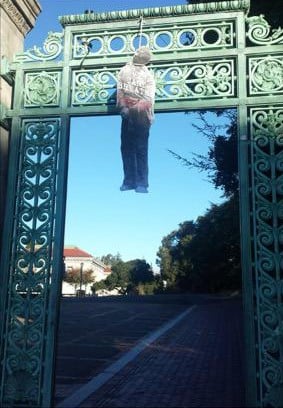
As peaceful protests decrying the deaths of black men Eric Garner and Michael Brown at the hands of the police took place across the country this weekend, an anonymous Bay Area art collective sparked controversy by hanging effigies around the campus of the University of California, Berkeley, which were created from cutting up blown-up photographs of historical lynchings of black men.
Initially, the motivations behind the lynching effigies was unclear, causing many to speculate that they were intended to promote fear and racism, rather than support the protests. Though protest art has become a powerful weapon in the widespread outrage in the wake of the two deaths and the subsequent grand jury decision not to indict in either case (see “Beloved Illustrator Blasted by Fans Over Ferguson Artwork” and “Missouri Museum to Preserve Ferguson Protest Art“), the effigies were, for many, a step too far.
Known for being a hotbed of political protests, Berkeley was set to host a black student union-organized demonstration against the police when the provocative effigies were found hanging in prominent locations on campus Saturday morning. More than 300 people participated in the Berkeley event, with a larger protest held later in the afternoon in nearby Oakland. In total, six effigies were hung in Berkeley and Oakland, each depicting a different victim of lynching, identified by name and date.
“Given the volatility of the protests, I think it’s misguided regardless of the protest,” UC Berkeley social psychology professor Rodolfo Mendoza-Denton, who specializes in stereotyping and social prejudice, told the Associated Press. “It’s inflammatory and is triggering upset and anger.”
The university’s chancellor, Nicholas B. Dirks, and provost, Claude Steele, urged those responsible to come forward.
A statement taking credit for the images from a self-described anonymous collective of queer, black, and people-of-color artists explained that “the images connect past events to present ones—referencing endemic faultlines of hatred and persecution that are and should be deeply unsettling to the American consciousness.”
The group apologized to those “who felt further attacked by this work,” assuring them that “your pain is ours.”